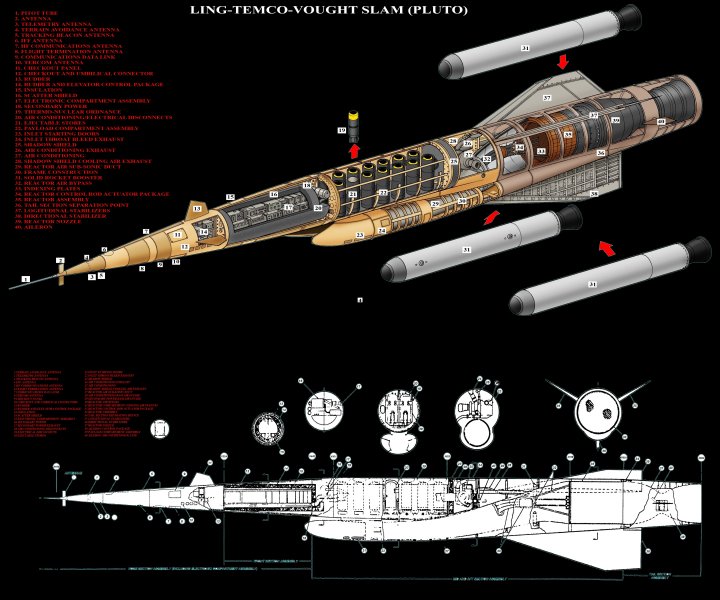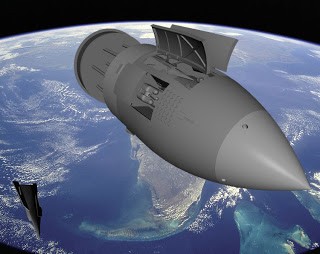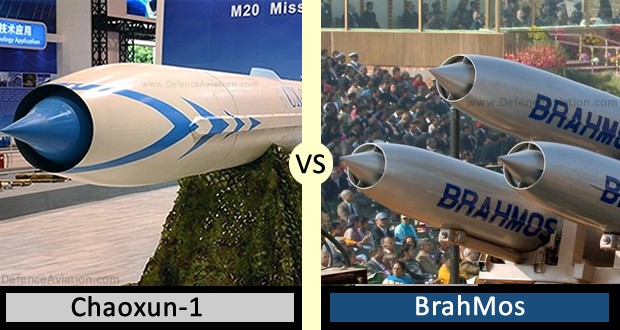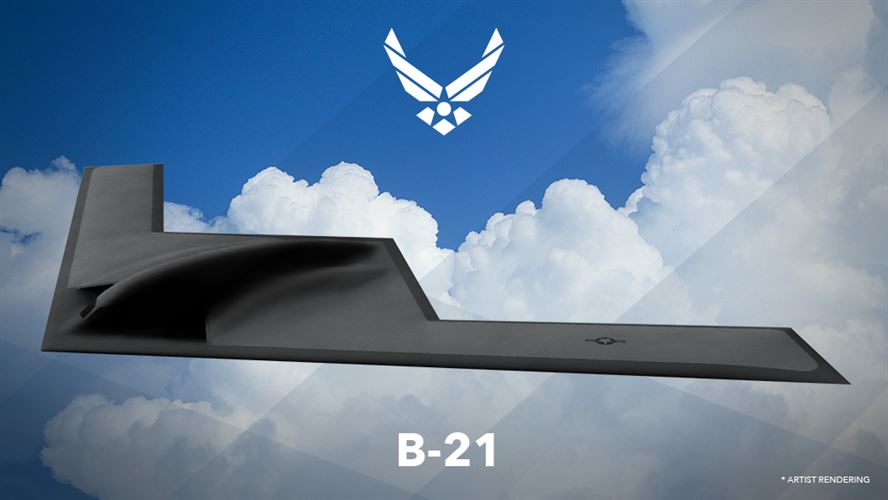In the 1950’s, scientists and engineers were proposing and developing a lot nuclear-powered concepts from elevators and cars on up to aircraft, spacecraft, and ships to replace a number of things like petroleum. However, biggest supporter of these nuclear-powered concepts were the U.S military which they’ve seen a lot of potential of these systems for a number of different roles. While the U.S Navy seen potential in nuclear-powered warships like cruisers, aircraft carriers and submarines in which the latter two would become the dominate part of the U.S Navy doctrine. At the same time, the United States Air Force was too, looking at nuclear-powered engines for a number of aircraft like strategic bombers or transport aircraft for a number of roles. Nevertheless, the USAF was also proposing two, but very radical concepts which at the time was very much top secret in the mid-1950’s. The two projects that the USAF was working on called Project PLUTO/SLAM and a variant of the Project Orion spaceship called the Orion orbital-battleship.
Project Pluto and the Vought Supersonic Low Attitude Missile (SLAM)
In the mid-1950’s, the United States Air Force Strategic Air Command, U.S Atomic Energy Commission and Vought were working on nuclear-powered cruise missile under the designation called Project Pluto. The Strategic Air Command or SAC was looking at the Project Pluto cruise missile to supplement or even replace their existing bomber fleet the like the Boeing B-47 Stratojet, Boeing B-52 Stratofortress, and the Convair B-36 Peacemaker strategic nuclear role during that era. The USAF gave the contract to Vought to build the Project Pluto nuclear-powered cruise missile in 1955.
While during that time, the USAF, Vought, NACA were looking at the engines to power the SLAM cruise missile. So, they’ve decided to look at other USAF and NACA programs which were also developing nuclear-powered engines for the Convair NB-36H, Convair X-6, and the less known WS-125 or B-72 bomber projects in which Convair and Lockheed were on along General Electric and Pratt & Whitney for the engines. The engine development took place at Jackass Flatts in Western Nevada in the late-1950’s for the Project Pluto program. The two new engine prototypes were known as Troy-IIA and Troy-IIC were built and tested by the USAF and the U.S Atomic Energy Commission for the project. Both engines were tested on modified railcars which were launched straight down track with the nuclear-powered ramjets powered on during the testing. The nuclear-powered ramjets were considered a success and would be used in the Project Pluto development. A flight test was planned for the prototype in the mid-1960’s, in which it would launched from the West Coast of the U.S to the Pacific Ocean, but the project was canceled before any of those were carried out.
Later though, Project Pluto would later become known as SLAM or Supersonic Low Attitude Missile which was being developed by Vought LTV Company for the United States Air Force Strategic Air Command for their requirement. Vought SLAM was an all-around “doomsday machine” which carried around 14-26 (depends on the variant) one megaton thermonuclear warheads which were launched from its fuselage, while its engines were spewing toxic radiation from its exhaust which would have poisoned the area when it was flying over. Its engines were also like a sonic weapon because its sonic booms could damage infrastructures and person hearing too. Once the SLAM used all its warheads, the missile would crash into ocean or another target adding to the radiation chaos in the area. SLAM was to be launched from three conventional rocket boosters from a railcar, stationary launcher, and from the proposed Armadillo hardened launch vehicles which was also being developed by Vought at the time for the SLAM and other missile systems from anywhere in the continental United States at targets in the Soviet Union, Warsaw Pact nations, and China. Range for the SLAM missile was over 100,000 miles which can circumvent four times around the world and was capable of loitering for days and even weeks if need be. It speed was over Mach 4 which would outrun any fighters and interceptors that was in service or being built like the Mikoyan & Gurevich MiG-25 Foxbat for example. Most surface to air missiles (SAM) were useless against the SLAM since they were aimed at high attitude targets like the B-47 and B-52 bombers, while the low attitude SAM’s were coming in service or were too slow against the cruise missile during that era.

However, despite the advantages of the Supersonic Low Attitude Missile, the system had some major drawbacks to. One of the biggest drawbacks were from the engine spewing radiation from its exhaust which was considered a good thing against the enemy, but a bad idea if it flew over friendly territory and contaminating the area too. Not only that, the SLAM launch systems would be based in the West, South and East coast of the United States since firing the missile from middle of nation wasn’t great idea either. Another problem with system along with a number nuclear-powered engines and aircraft is that there were technical issues like the shielding for example even despite the SLAM was unmanned cruise missile. One of the big issues surrounding the SLAM project and other nuclear-powered aircraft and rockets were they were very expensive costing up to billions of dollars in research and development. While unrelated, one of the biggest fears that the Soviets would make similar to the SLAM which could be used against the United States and NATO nations in Europe. Despite these factors and the matured development of ICBM’s like the SM-65/HGM-16 Atlas, LGM-31 Minuteman, and the HGM-25 Titan along with the USN ballistic missile submarines capable firing the UGM-27 Polaris SLBM’s made the SLAM cruise missile redundant and the project was later canceled in 1964.
Orion Nuclear-Powered Orbital Battleship
In 1955, NACA (later to be known as NASA) was working on a nuclear-powered spaceship for trips to near-Earth orbit up to interstellar travel to neighboring star systems like Alpha Centauri. Nonetheless, the United States Air Force gotten involved in the Project Orion program which they’ve wanted it spacecraft to deliver satellites and crew members to orbiting space stations. However, one of the most radical, but little known USAF Project Orion proposals was the nuclear-powered orbital battleship that was proposed in the late-1950’s. While this system seems like something out of a science fiction novel or a movie, the massive nuclear-powered armed spaceship would orbit high above the Earth and if needed be, unleashes it nuclear payload on multiple targets.
The Orion orbital battleship was post to use a massive nuclear pulse rocket engine that used fission material bombs to power the giant spacecraft. Original plan was to launch the spacecraft to orbit using its nuclear-powered rocket from bases in Southwestern United States or from special launch platforms in the ocean like aircraft carriers or modified ships. However, due to safety reasons and nuclear fallout, they’ve decided to launch it instead using chemical rockets to Earth’s orbit. Orion was a giant massive spacecraft which was 286ft which was taller than most skyscrapers in that era and 164ft in diameter. It would had a crew of close to thirty people onboard that would have operated the orbital battleship. The spacecraft would use a special damper or shock absorbers and shielding to protect the crew from radiation from the ship’s engines and space. Nevertheless a unmanned variant of the Orion orbital battleship was planned too Furthermore, Orion also carried five smaller spaceplanes for resupplies, crew replacements, and emergency life boat in case the Orion was having problems or was getting attacked. It was also quite possible that those small spacecraft were used in defensive and offensive roles including protecting the Orion from Soviet spaceplanes and satellites along with providing reconnaissance and strike roles if necessary
Nevertheless though, the main mission for the Orion battleship would be nuclear deterrence against nations like the Soviet Union, China, and Warsaw Pact nations. The orbital battleship would carry up to 500 20MT nuclear warheads in the frontal part of the spaceship which can be fired downwards while orbiting above a target. However, another radical, but pretty much a doomsday device was an unmanned variant of the Orion battleship armed with a single 3GT (possibly the largest nuclear warhead ever proposed by any nation) nuclear warhead! The ship would fire the warhead or use the ship itself as weapon to strike at its target. Along with its nuclear warheads, the Orion orbital battleship carried massive array of defensive weapon systems like direct-energy weapons, five Mark 42 127mm naval guns, and ten, but mysterious Casaba howitzer which fired a special shaped rounds. The Orion battleship would have lived up to its name since it was armed like a naval battleship on the high seas. The United States Air Force was planning to have a fleet of these orbital battleships in space as a deterrent against the Soviet Union and his allies.

Nonetheless, even despite all these features and equipment for the Orion orbital battleship, there were still a lot problems the design. One of the issues which faced the whole Project Orion program was the issue over the damper and shock absorbers to protect the ship and crew from the nuclear blast form the engines. Nevertheless, the engineers were on ways fixing the shock absorber and damper issue along with improving the shielding protection for the crewmembers would be operating the battleship. Another problem was the cost since the whole Project Orion program would cost over billions of dollars to manufacture and build despite these giants. Furthermore, another big issue was the concern of safety since the last thing is having a massive accident or a failure with an orbital spaceship carrying over 500 20MT or a single 3GT nuclear warheads going at once would have resulted in total annihilation around the area along with a global nuclear winter too for decades. A top of that, there were fears from meteorites and other space debris along with accidental or glitch that can send warheads or the battleship into de-orbit mode which wouldn’t be pretty either. But the biggest issue was political since the U.S and the Soviets sign the Partial Test Ban Treaty in 1963 which banned testing nuclear weapons or any other nuclear devices in the high atmosphere which would later prove to be a final death nail for the Orion nuclear-powered battleship along with whole Project Orion program. Nonetheless, there is a story that USAF officials showed a model and told him details about the Orion orbital battleship to then President John F. Kennedy in which he got “freaked out” over the proposal that he canceled the project the second he hearing about it! While the project has been officially canceled in the early-1960’s, very little is known about the Orion orbital battleship proposal and a lot of details are still very much classified too this day including its nuclear weapons system and Casaba Howitzer.
Conclusion
While both Supersonic Low Attitude Missile and the Orion orbital battleship look good on paper, but both had more serious drawbacks to them than then pros. The main problem of the concepts were the engines which would leave a lot of radioactive fallout which can last for days, up to even years over both friendly and enemy terrain. While safer and better nuclear-powered were planned, but a lot them were turned due cost and weight issues. So, the USAF and other defense companies decided to use the cheaper, but “dirty” nuclear-powered engines which were easier to maintain. Another problem that was a major concern was the safety and the fears of a “broken arrow” incident which has happened before in the past with nuclear weapons and would be worst not only with nuclear weapons, but also the missile and spacecraft being powered by nuclear engines. Like I said before, while these systems have advantages like having unlimited range and needing no crew or supplies (with the exception of the manned Orion orbital battleship), the systems themselves were ticking time bombs ready to exploded because the amount of risk and volatility of these systems. So, extreme care would had to be in place to keep these systems safe from accidents, intentional, and other issues which have been expensive and very complicated to maintain.





